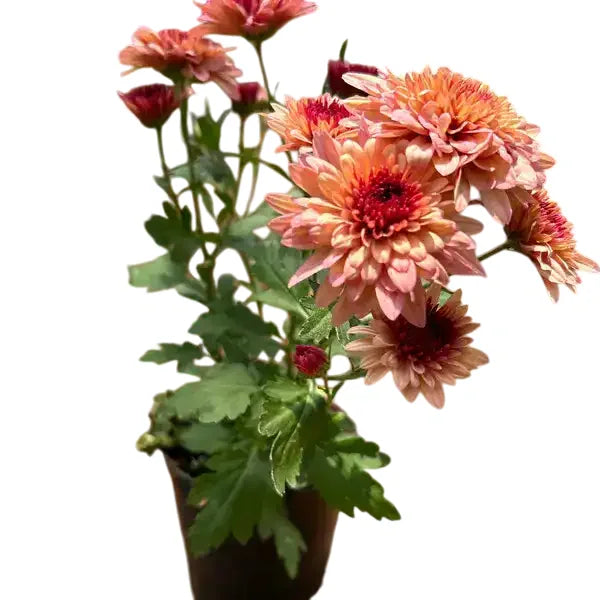
Jamanthi,Chrysanthemum Peach - Rare
Selling Size : Bushy Plant | Pot Included | Secure packing
"Jamanthi" is the local name for Chrysanthemum in many parts of India, particularly in Malayalam (Kerala) and Tamil languages. These beautiful flowering plants are very popular for their vibrant blooms, especially during festive seasons.
Here's a comprehensive guide to caring for Jamanthi (Chrysanthemum) plants:
1. Light:
Full Sun: Jamanthi plants are sun-lovers and require at least 5-6 hours of direct sunlight daily for abundant blooming.
Partial Shade in Hot Summers: In tropical and subtropical regions like India, especially during the peak of summer, intense afternoon sun can be too harsh. It's advisable to provide some afternoon shade or move potted plants to a shadier spot during the hottest part of the day to prevent scorching.
2. Soil:
Well-Draining Soil: This is crucial. Jamanthi plants hate soggy feet, which can lead to root rot.
Rich in Organic Matter: They thrive in fertile soil. A good potting mix would include garden soil, compost or well-rotted cow manure, and some sand or perlite for drainage. Sandy loam soil is often recommended.
pH: They generally prefer a slightly acidic to neutral pH.
3. Watering:
Regular Watering: Since they need a lot of sun, they tend to dry out quickly, especially in pots. Water regularly, especially when the top inch or two of soil feels dry to the touch.
Thorough Watering: Water until it drains from the bottom of the pot.
Avoid Wetting Foliage: Try to water the base of the plant to avoid wetting the leaves. Wet leaves can lead to fungal diseases like powdery mildew and rust.
Mulching: Applying a layer of mulch around the base of the plant can help retain soil moisture and reduce the need for frequent watering, especially in sunny locations.
4. Temperature:
Ideal Range: Jamanthi plants generally prefer temperatures between 20∘C to 30∘C (68∘F to 86∘F).
Heat Stress: High summer temperatures (above 35∘C or 95∘F) can cause stress, leading to less vigorous growth and fewer blooms. Providing shade during the hottest part of the day can help.
5. Fertilization:
Moderate Feeder: Jamanthi plants are not heavy feeders but benefit from regular nourishment.
During Growing Season (Spring-Summer): Fertilize every 2-4 weeks with a balanced liquid fertilizer (e.g., NPK 10-10-10 or 20-20-20) diluted to half strength.
Blooming Season: Once buds start to form and during blooming, switch to a fertilizer higher in phosphorus (the middle number in NPK) to promote more flowers.
Organic Options: Well-rotted cow manure or compost can be incorporated into the soil every month or two.
Reduce in Winter: Reduce or stop fertilizing during the dormant period (winter).
6. Pruning and Deadheading:
Pinching: When the plant is young and about 6-8 inches tall, pinch off the growing tips. This encourages bushier growth and more branches, leading to more flowers. Repeat pinching every few weeks until about 2-3 months before you want blooms.
Deadheading: Regularly remove spent or faded flowers (deadhead) by pinching or snipping them off. This redirects the plant's energy from seed production to producing new blooms, extending the flowering period.
Post-Flowering Pruning: After the main flowering season is over and the blooms have faded, you can cut back the entire plant significantly, leaving only 2-3 inches of stem above the soil. This rejuvenates the plant for the next season. Reduce watering after this drastic prune.
7. Propagation:
Cuttings: This is the most common and effective method. Take 4-6 inch cuttings from healthy, non-flowering stems, remove lower leaves, dip in rooting hormone (optional), and plant in a well-draining rooting medium.
Division: Perennial varieties can be divided in spring.
Seeds: While possible, growing from seeds takes longer to flower and the resulting plants may not be true to the parent variety.
8. Pests and Diseases:
Common Pests: Watch out for aphids, spider mites, thrips, and leaf miners.
Treatment:
Manual removal: For minor infestations, wipe them off with a damp cloth or spray with a strong jet of water.
Neem oil: A natural pesticide that works well.
Insecticidal soap: Effective for controlling various pests.
Common Diseases: Powdery mildew and rust are common fungal diseases, especially in humid conditions with poor air circulation.
Prevention: Ensure good air circulation, avoid overhead watering, and space plants adequately.
Treatment: Fungicides can be used if the problem is severe.
Important Tips for Jamanthi in India:
Seasonal Care: Jamanthi plants are often treated as annuals in some parts of India, planted for their vibrant blooms and then discarded. However, with proper care and pruning, many varieties can be perennial.
Monsoon Care: During the monsoon season, ensure excellent drainage to prevent waterlogging and root rot. Good air circulation is vital to prevent fungal issues.
Winter Dormancy: In colder regions, Jamanthi plants may go dormant in winter. Reduce watering and stop fertilizing. They will bounce back in spring.
With consistent care and attention to its light, water, and soil needs, your Jamanthi plants will provide a spectacular display of colorful blooms!

